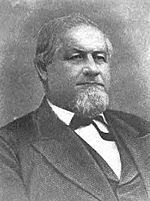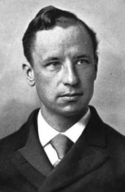John M. Palmer (politician) facts for kids
Quick facts for kids
John Palmer
|
|
|---|---|
 |
|
| United States Senator from Illinois |
|
| In office March 4, 1891 – March 3, 1897 |
|
| Preceded by | Charles B. Farwell |
| Succeeded by | William E. Mason |
| 15th Governor of Illinois | |
| In office January 11, 1869 – January 13, 1873 |
|
| Lieutenant | John Dougherty |
| Preceded by | Richard J. Oglesby |
| Succeeded by | Richard J. Oglesby |
| Personal details | |
| Born |
John McAuley Palmer
September 13, 1817 Eagle Creek, Kentucky, U.S. |
| Died | September 25, 1900 (aged 83) Springfield, Illinois, U.S. |
| Political party | Democratic (before 1848, 1852–1856, 1872–1896) Free Soil (1848–1852) Republican (1856–1870) Liberal Republican (1870–1872) National Democratic (1896–1900) |
| Education | Shurtleff College |
| Military service | |
| Allegiance |
|
| Branch/service | United States Army Union Army |
| Years of service | 1861–1866 |
| Rank | |
| Commands | XIV Corps |
| Battles/wars | American Civil War |
John McAuley Palmer (September 13, 1817 – September 25, 1900) was an important person from Illinois. He was a general in the American Civil War, fighting for the Union (the North). Later, he became the 15th governor of Illinois. He even ran for president in 1896.
Palmer changed his political party many times during his life. He started as a Democrat. Then he became an anti-slavery Democrat, a Republican, and a Liberal Republican. He returned to being a Democrat and ended up as a "Bourbon Democrat." He once said he wasn't "a slave of any party" and thought for himself.
Contents
Early Life and Political Start
John Palmer was born in Eagle Creek, Scott County, Kentucky. In 1831, his family moved to Alton, Illinois. They were quite poor, but John worked hard to pay for his college education. In 1839, he became a lawyer. He married Malinda Ann Neely in 1842, and they had ten children. Besides being a lawyer, he also worked as a school teacher and sold clocks.
In 1848, Palmer was part of a group that helped write the state's constitution. From 1852 to 1855, he was a Democrat in the Illinois Senate. But he later joined the new Republican Party and became a key leader in Illinois.
In 1856, he led the first Republican Convention in Bloomington, Illinois. This meeting officially started the Republican Party in his home state. In 1860, he was chosen to be a presidential elector. He also played a big part in getting his friend, Abraham Lincoln, nominated for president. In 1861, Lincoln asked him to be a delegate at a peace meeting in Washington, but it failed to find a compromise.
Service in the Civil War
During the American Civil War, John Palmer joined the Union army. He started as a colonel and rose to the rank of major general. He joined in 1861 and led the 14th Illinois Infantry. He served under John C. Frémont in an effort to stop the rebellion in Springfield, Missouri.
In December 1861, he was promoted to brigadier general. He helped capture New Madrid and Island No. 10. After getting sick, he went home to get better. He then helped create a new regiment, the 122nd Illinois Infantry.
Palmer returned to the field and was promoted to major general in November 1862. He was very important in the Battle of Stones River, where his troops held a key position. He also led his soldiers well during the Battle of Chickamauga in September 1863.
He commanded the XIV Corps during the Chattanooga Campaign in 1863. He also served under George Henry Thomas in the Atlanta Campaign. In August 1864, Palmer questioned an order from a younger general, John Schofield, who outranked him. After a delay, Palmer resigned in protest. This was a very unusual event during the war.
In early 1865, Palmer was sent to command all Union forces in Kentucky. He helped the Union take control of the state. He also worked to end slavery there, even though Kentucky was not part of the Emancipation Proclamation. He believed slavery was wrong and wanted to get rid of it. He allowed Black men to join the army and helped protect the families of Black soldiers. He also issued "free passes" that allowed African Americans to travel freely. In 1865, he declared to a large crowd in Louisville, "My countrymen, you are free."
After the War: Governor and Senator
In 1866, Palmer left the army. Two years later, he was elected Governor of Illinois as a Republican. He served one term. In the 1872 presidential election, he received three electoral votes for vice president.
In 1891, he was elected to the U.S. Senate as a Democrat. He served one term there.
Presidential Dreams in 1892
In 1892, John Palmer was seriously considered as a possible candidate for president. Some Democrats in Chicago thought of him as a "safe" choice. Palmer even made a deal with Patrick A. Collins, a former Congressman from Massachusetts. Their plan was for Palmer to be the presidential candidate and Massachusetts Governor William Russell to be his running mate. They thought Palmer would appeal to Southern Democrats, and Russell would bring in support from New England.
Before the 1892 Democratic National Convention, many Illinois Democrats supported Palmer for president. However, Palmer himself supported former president Grover Cleveland. He even went to the convention in Chicago to tell people not to nominate him.
Running for President in 1896
In 1896, Palmer ran for president as the candidate for the National Democratic Party. This party was a group of conservative Democrats who disagreed with the main Democratic Party's ideas about money. They supported the "gold standard" instead of "free silver." His running mate was Simon Bolner Buckner, Sr., a former Confederate general. The idea was that two former generals, one from the Union and one from the Confederacy, would show national unity.
The main issue in the 1896 election was about currency. The regular Democratic Party wanted "free silver," which meant tying the U.S. dollar to silver at a 16-to-1 ratio with gold. Palmer believed this would harm the economy. He thought it was important to stick to the gold standard, where the value of money was based on gold.
Palmer and his party believed in small government and individual freedom. They thought the main Democratic Party had lost these ideals. Even though Palmer was 79 years old, he campaigned actively. However, most voters chose other candidates. Palmer and Buckner received just over 1% of the votes.
John Palmer died from a heart attack in Springfield, Illinois, on September 25, 1900. He is buried in the City Cemetery in Carlinville, Illinois. A school in Chicago, John M. Palmer Elementary School, is named in his honor.
See also
- List of American Civil War generals (Union)




